WinHEC 2005 - Keynote and Day 1
by Derek Wilson & Jarred Walton on April 26, 2005 4:00 AM EST- Posted in
- Trade Shows
Beyond XP-64
XP-64 wasn't the only major topic covered in the keynote. The other major topic was the next generation of Windows, codenamed Longhorn. There were several demonstrations of Longhorn features and capabilities, although there really wasn't a whole lot of new content shown. Gates also showed off several of the new tablet PC devices, but again, there wasn't anything really amazing to report. Here are a couple of gratuitous shots of these devices before we move on to Longhorn.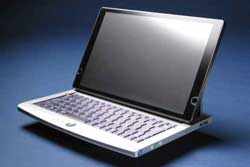 |
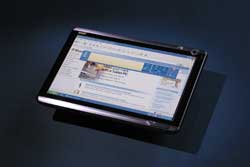 |
For those of you that know nothing about Longhorn, here are a few of the interesting tidbits. For starters, Longhorn will release simultaneously in 32-bit and 64-bit versions. In other words, 32-bit OS and system support will continue for quite a few more years, as Longhorn isn't scheduled to ship before the holiday 2006 time frame. Longhorn will also represent the most significant redesign of the Windows UI since the upgrade from Windows 3.1 to Windows 95 - or at least, that's what Microsoft is claiming.
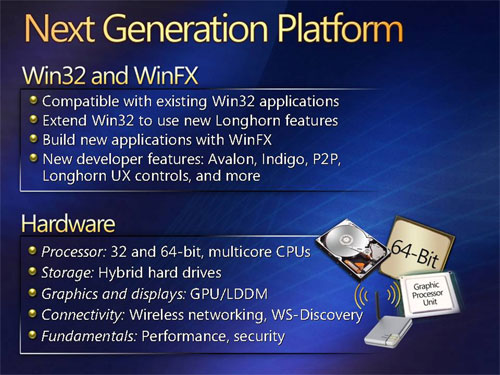
The above represents the broad plans for Longhorn in terms of features and hardware. WinFX is one of the core changes, and it relates to the way all of the GUI functions will be handled. 3D hardware acceleration with pixel shaders, alpha blending (transparency) and other graphical effects - a cynic might suggest that many look like stuff we've seen in OS X - are going to be a major part of the new OS.
One of the interesting points is that the graphics in Longhorn will be vector based, allowing for zooming effects without the pixelization that we get with the current model. This extends even further to areas like the new Metro document format. Metro is a royalty free standard based off of XML that Microsoft has created for Longhorn. The idea is that it will allow better translation of documents between various formats.
To illustrate this, MS gave a brief demonstration of a prototype printer with hardware support for the Metro format, with an example of a PowerPoint slide printed using the current driver model as well as the new Metro model. Frankly, we're not sure what the point was with the demonstration, other than to show that some programs don't print properly - PowerPoint apparently being a culprit. Anyway, Metro sounds like a new take on the PostScript concept, only without royalties. Royalty-free isn't a bad idea, certainly, but this feels quite a bit like the old browser wars. Take something another company makes for free and clone it, then integrate it into the Windows OS and give it away for free. Consumers might like it, but competitors don't all benefit from the decisions.
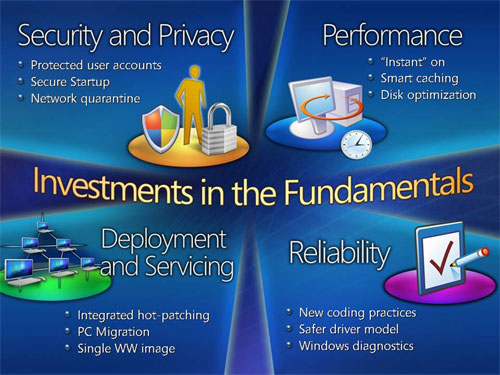
The purpose of Longhorn as a whole continues to be improving the computing experience, with security, performance, reliability, and service all playing a role. In order to realize this goal, changes are coming with Longhorn. One of the major changes will be the new driver model and certification program. We'll have more to say on that later.
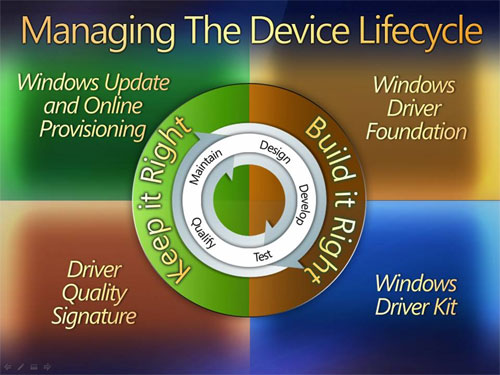
Windows Update will also be getting a renovation, with improved support. Gates suggested that in the future, users will all run WHQL certified drivers because there will be no need to use unsigned drivers. Hopefully, that will come by improving driver quality rather than by relaxing the requirements to gain certification.










36 Comments
View All Comments
JarredWalton - Saturday, April 30, 2005 - link
KHysiek - part of the bonus of the Hybrid HDDs is that apparently Longhorn will be a lot more intelligent on memory management. (I'm keeping my fingers crossed.) XP is certainly better than NT4 or the 9x world, but it's still not perfect. Part of the problem is that RAM isn't always returned to the OS when it's deallocated.Case in point: Working on one of these WinHEC articles, I opened about 40 images in Photoshop. Having 1GB of RAM, things got a little sluggish after about half the images were open, but it still worked. (I wasn't dealing with layers or anything like that.) After I finished editing/cleaning each image, I saved it and closed it.
Once I was done, total memory used had dropped from around 2 GB max down to 600 MB. Oddly, Photoshop was showing only 60 MB of RAM in use. I exited PS and suddenly 400 MB of RAM freed up. Who was to blame: Adobe or MS? I don't know for sure. Either way, I hope MS can help eliminate such occurrences.
KHysiek - Friday, April 29, 2005 - link
PS. In this case making hybrid hard drives with just 128MB of cache is laughable. Windows massive memory swapping will ruin cache effectiveness quickly.KHysiek - Friday, April 29, 2005 - link
Windows memory management is one of the worst moments in history of software development. It made all windows software bad in terms of managing memory and overall performance of OS. You actually need at least 2x of memory neede by applications to work flawlessly. I see that saga continues.CSMR - Thursday, April 28, 2005 - link
A good article!Regarding the "historical" question:
Strictly speaking, if you say "an historical" you should not pronounce the h, but many people use "an historical" and pronounce the h regardless.
Pete - Thursday, April 28, 2005 - link
That's about how I reasoned it, Jarred. The fisherman waits with (a?)bated breath, while the fish dangles from baited hook. Poor bastard(s).'Course, when I went fishing as a kid, I usually ended up bothering the tree frogs more than the fish. :)
patrick0 - Wednesday, April 27, 2005 - link
If Microsoft manages graphics memory, it will sure be a lot easier to read this memory. This can make it easier to use the GPU as a co-processor to do non-graphics tasks. Now I could manage image-processing, but this doesn't sound like a no-graphcs task, does it? Anyways, it is a cpu task. Neither ATI nor nVidia has made it easy so far to use the GPU as co-processor. So I think ms managing this memory will be an improvement.JarredWalton - Wednesday, April 27, 2005 - link
Haven't you ever been fishing, Pete? There you sit, with a baited hook waiting for a fish to bite. It's a very tense, anxious time. That's what baited breath means.... Or something. LOL. I never really thought about what "bated breath" actually meant. Suspended breath? Yeah, sure... whatever. :)Pete - Wednesday, April 27, 2005 - link
Good read so far, Derek and Jarred. Just wanted to note one mistake at the bottom of page three: bated, not baited, breath.Unless, of course, they ordered their pie with anchovies....
Calin - Wednesday, April 27, 2005 - link
"that Itanium is not dead and it's not going anywhere"I would say "that Itanium is not dead but it's not going anywhere"
JarredWalton - Tuesday, April 26, 2005 - link
26 - Either way, we're still talking about a factor of 2. 1+ billion vs. 2+ billion DIMMs isn't really important in the grand scheme of things. :)23 - As far as the "long long" vs "long", I'm not entirely sure what you're talking about. AMD initially made their default integer size - even in 64-bit mode - a 32-bit integer (I think). Very few applications really need 64-bit integers, plus fetching a 64-bit int from RAM requires twice as much bandwidth as a 32-bit int. That's part one of my thoughts.
Part 2 is that MS may have done this for code compatibility. While in 99% of cases, an application really wouldn't care if the 32-bit integers suddenly became 64-bit integers, that's still a potential problem. Making the user explicitly request 64-bit integers gets around this problem. Things are backwards compatible.
Anyway, none of that is official, and I'm only partly sure I understand what you're asking in the first place. If you've got some links for us to check out, we can look into it further.